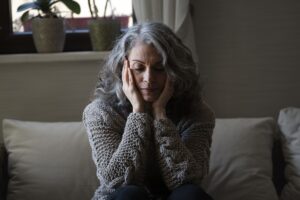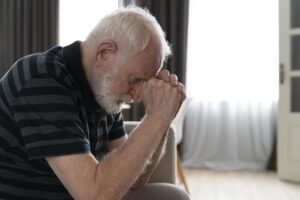Understanding and Managing Anxiety in Older people
Understanding these nuances is crucial for caregivers, medical professionals, and families. This article seeks to delve deeply into the nature of anxiety disorders prevalent among the elderly. It will explore the various causes behind these anxieties, the symptoms that distinctly manifest in this age group, and the most effective treatment methods available. By providing a thorough understanding of these aspects, the article aims to enhance awareness and foster better support systems for older individuals dealing with anxiety, ensuring they receive the appropriate care and attention needed to maintain their mental health and overall well-being.
Anxiety Symptoms in Older Adults
Older adults may experience anxiety symptoms that are both common and unique to their age group. These can include excessive worrying, restlessness, difficulty concentrating, and physical symptoms like fatigue or heart palpitations. It’s important to understand these symptoms in the context of aging, as they can often be overlooked or mistaken for other medical conditions.
In older people, anxiety symptoms can be multifaceted, often blending common signs with those unique to this demographic. They may experience a persistent state of excessive worrying, which can significantly disrupt their daily life. This worrying is often accompanied by restlessness and a notable difficulty in concentrating, which can exacerbate feelings of distress.
Physically, older people may experience symptoms such as:
- chronic fatigue
- muscle tension
- rapid heartbeat, which are often misinterpreted as signs of other diseases.
It is critical to recognize these symptoms in the context of aging as they can be easily overlooked or misdiagnosed, leading to inadequate treatment and care. Understanding and identifying these signs early is critical to providing practical support and improving overall well-being.
Anxiety disorders in older people
Anxiety disorders in r people can manifest as distinct conditions, each with its own set of problems.
- Generalized anxiety disorder (GAD) is common. It is characterized by long-term anxiety that is not focused on any one object or situation, resulting in a persistent state of worry or fear.
- Panic disorder is another condition that can be particularly distressing for older adults, characterized by sudden periods of intense fear or discomfort, often accompanied by physical symptoms such as chest pain or rapid heartbeat.
Phobias, or irrational fears of specific objects or situations, may also be prevalent in this age group. The impact of these disorders on older people can be profound, affecting their daily functioning, social interactions, and overall quality of life. It is essential to recognize and treat these disorders promptly to mitigate their effects and help older people maintain a sense of normalcy and well-being. Dual, they are considering their overall health and any other medical conditions.
Most Common Types of Anxiety in Older People
- Generalized Anxiety Disorder (GAD): A prevalent form marked by persistent, excessive worrying about various aspects of life.
- Social Anxiety Disorder: Characterized by an intense fear of social interactions, leading to avoidance of social situations.
- Panic Disorder: Involves sudden, unexpected panic attacks accompanied by physical symptoms like heart palpitations and shortness of breath.
- Phobias: Strong, irrational fears of specific objects or situations.
- Obsessive-Compulsive Disorder (OCD): Recurrent, unwanted thoughts (obsessions) and repetitive behaviors (compulsions) driven by anxiety.
Understanding these types can facilitate more effective identification and treatment of anxiety in older adults.
Causes of Anxiety in Older People
Anxiety in older people can stem from a variety of sources:
- Health-Related Issues: Chronic illness, pain, or medication side effects.
- Brain Changes: Neurological alterations due to aging that affect mood and cognition.
- Grief: Loss of loved ones, leading to feelings of loneliness and heightened anxiety.
- Environmental Changes: Moving to new living situations, like nursing homes, which can be disorienting and stressful.
- Psychosocial Factors: Reduced social support, financial worries, or fear of dependency.
Identifying these causes is critical for addressing and managing anxiety effectively.
Mental Changes and Their Impact on Anxiety in Older People
Mental changes in older people, particularly cognitive decline, can have a significant impact on anxiety levels:
Cognitive Decline: Memory loss, confusion, and other cognitive impairments can exacerbate anxiety symptoms.
Mood Disorders: Depression and other mood disorders often co-occur with anxiety, complicating the clinical picture.
Perception of Health: Older people’s perception of their declining health can heighten anxiety, leading to a cycle of worsening symptoms.
Fear of Dependency: Worrying about becoming dependent on others can trigger or increase anxiety.
Importance of Differentiating from Normal Aging: It is crucial to distinguish these mental changes from normal aging processes to provide appropriate mental health care.
Role of Healthcare Providers: Attending hospitalists and other healthcare professionals play a vital role in recognizing these changes and coordinating care, including medication management, physiotherapy, and emotional support services.
Addressing these mental changes holistically is essential for alleviating anxiety in older individuals.
Signs of Anxiety in Older Adults
Identifying the signs of anxiety in older people is crucial for effective and timely intervention. These signs can vary widely and may include:
Changes in Sleep Patterns: Difficulty falling asleep or staying asleep or experiencing restless sleep.
Irritability and Mood Swings: Increased irritability or unexplained changes in mood.
Physical Symptoms:
- Unexplained aches and pains.
- A racing heart or palpitations.
- Trembling or shaking.
- Excessive sweating, often without physical exertion.
- Cognitive Signs:
- Obsessive thinking or rumination.
- Difficulty concentrating or memory problems.
Behavioral Changes:
There is a need for repetition in activities, such as excessive handwashing.
Avoidance of social situations or activities once enjoyed.
Emotional Distress:
Experiencing nightmares or sleep disturbances.
Sudden overreactions to minor stressors.
Persistent feelings of worry or fear.
Gastrointestinal Issues: Symptoms like nausea or stomach upset without a clear physical cause.
These signs are vital to monitor in older people, as they can be mistakenly attributed to aging or other health conditions.
Medication for Hospice Patients with Anxiety
In hospice care, managing anxiety effectively is critical for ensuring patient comfort and quality of life:
Careful Medication Selection: Medications must be chosen with caution to minimize adverse effects and interactions with other drugs.
Types of Medications:
Antidepressants are often used for their anxiolytic properties.
Benzodiazepines for short-term relief of severe anxiety symptoms.
Non-benzodiazepine anxiolytics, which can be safer for long-term use in older people
Monitoring and Adjusting Treatments: Continuous monitoring of medication effects and side effects is essential.
Holistic Approach: Alongside medication, incorporating other therapies like:
Physiotherapy to alleviate physical symptoms of anxiety.
Emotional support services, including counseling and support groups.
Role of Healthcare Providers: Attending hospitalists and healthcare teams play a pivotal role in assessing, managing, and coordinating the care of hospice patients with anxiety, ensuring a holistic and patient-centered approach.
Addressing anxiety in hospice care requires a thoughtful balance of pharmacological and non-pharmacological interventions tailored to the individual needs of each patient.
Physiotherapy Therapy for Older people with Anxiety
Physiotherapy stands as a crucial component in treating anxiety among older people Its focus extends beyond just physical rehabilitation to encompass holistic well-being. Key aspects include:
- Reducing Physical Pain: Addressing chronic pain that can exacerbate anxiety symptoms.
- Improving Mobility: Enhancing physical mobility to boost independence, reducing anxiety associated with physical limitations.
- Exercise Regimens: Tailored exercise programs that can alleviate symptoms of anxiety and improve overall mood.
- Relaxation Techniques: Incorporating methods such as deep breathing and progressive muscle relaxation.
- Physical and Mental Connection: Recognizing the interplay between physical health and mental well-being in olderpeople.
Emotional Support Services for Managing Anxiety in Older people
Emotional support services are vital in providing comprehensive care for older adults experiencing anxiety:
- Counseling Services: Offering one-on-one therapy sessions to address personal concerns and anxiety triggers.
- Support Groups: Facilitating group sessions where individuals can share experiences and coping strategies, fostering a sense of community.
- Community Resources: Providing access to community-based programs and activities that can help reduce feelings of isolation and anxiety.
- Holistic Approaches: Combining emotional support with other interventions like medication, physiotherapy, and lifestyle modifications.
- Education and Coping Strategies: Educating older adults and their families about anxiety and its management.
Role of the Attending Hospitalist in Managing Anxiety in Older people
The attending hospitalist plays a pivotal role in coordinating comprehensive care for older people with anxiety:
- Multidisciplinary Coordination: Collaborating with various healthcare professionals, including mental health specialists, physiotherapists, and counselors.
- Medication Management: Overseeing medication regimens to treat anxiety while being mindful of potential side effects and interactions, especially in hospice patients.
- Ongoing Assessment: Continuously assessing the patient’s mental state, adjusting treatments as necessary.
- Patient-Centered Care: Ensuring that care plans are tailored to the individual needs and preferences of the older adult.
- Family Involvement: Engaging family members in the care process and providing them with education and support.
Incorporating physiotherapy, emotional support services, and the coordinated efforts of an attending hospitalist can significantly enhance the management of anxiety in older people, leading to improved outcomes and better quality of life.
Understanding and managing anxiety in older people requires a compassionate and comprehensive approach. By recognizing the signs, understanding the causes, and implementing effective treatment strategies, it is possible to significantly improve the quality of life for older individuals suffering from anxiety.





Post Comments